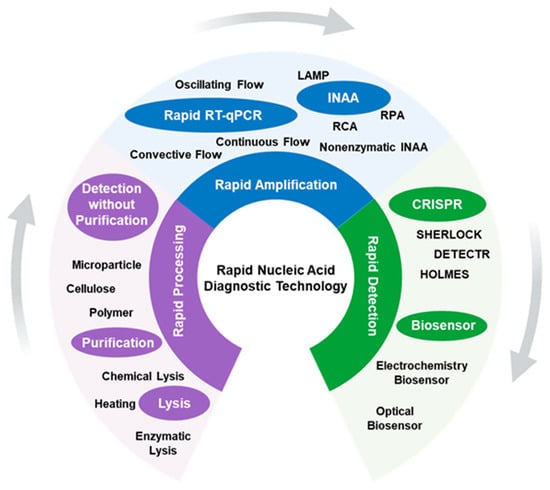Rapid Nucleic Acid Diagnostic Technology for Pandemic Diseases

🌈 Abstract
The article discusses rapid nucleic acid diagnostic technologies for pandemic diseases, covering topics such as rapid processing, rapid amplification, rapid detection, and conclusions and prospects.
🙋 Q&A
[01] Rapid Processing
1. Questions related to the content of the section?
- The article discusses various rapid processing techniques for nucleic acid detection, including:
- Rapid RT-qPCR
- Rapid isothermal amplification methods such as Loop-Mediated Isothermal Amplification (LAMP), Rolling Circle Amplification (RCA), Recombinase Polymerase Amplification (RPA), and Nonenzymatic INAA
- These techniques aim to provide fast, sensitive, and efficient nucleic acid detection for pandemic diseases.
[02] Rapid Amplification
1. What are the key rapid amplification methods discussed in the article?
- The article covers the following rapid amplification methods:
- Rapid RT-qPCR
- Rapid isothermal amplification techniques:
- Loop-Mediated Isothermal Amplification (LAMP)
- Rolling Circle Amplification (RCA)
- Recombinase Polymerase Amplification (RPA)
- Nonenzymatic INAA
2. What are the advantages of these rapid amplification methods?
- The rapid amplification methods discussed aim to provide fast, sensitive, and efficient nucleic acid detection for pandemic diseases, with reduced processing time compared to traditional methods.
[03] Rapid Detection
1. What rapid detection techniques are covered in the article?
- The article discusses the following rapid detection techniques:
- CRISPR-based detection
- Physical and chemical biosensors, including:
- Electrochemistry biosensors
- Optical biosensors (e.g., Surface-Enhanced Raman Scattering (SERS), Surface Plasmon Resonance (SPR))
2. How do these rapid detection techniques work and what are their advantages?
- CRISPR-based detection provides rapid, sensitive, and specific nucleic acid detection.
- Electrochemical and optical biosensors enable fast, label-free, and sensitive detection of target analytes.
- These rapid detection methods aim to enable point-of-care testing and expedite pandemic response.
[04] Conclusions and Prospects
1. What are the key conclusions and future prospects discussed in the article?
- The article concludes that the rapid nucleic acid diagnostic technologies covered, including rapid processing, amplification, and detection methods, have the potential to significantly improve pandemic response capabilities.
- The article suggests that further development and integration of these technologies can lead to more widespread, accessible, and effective diagnostic solutions for future pandemic diseases.
Shared by Daniel Chen ·
© 2024 NewMotor Inc.